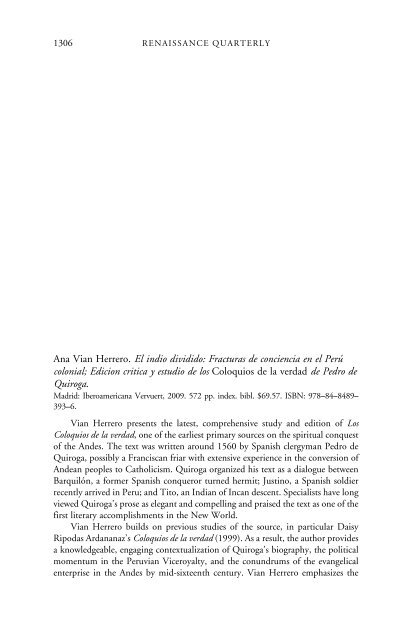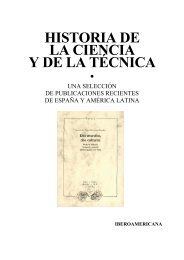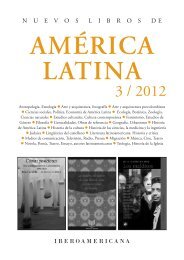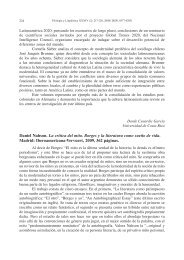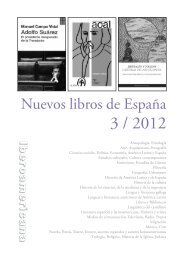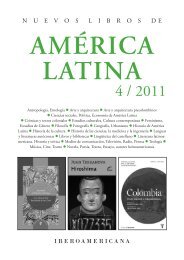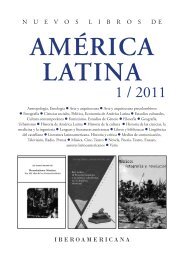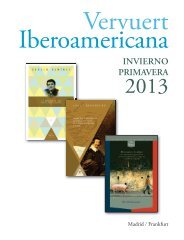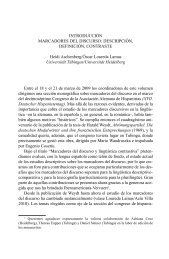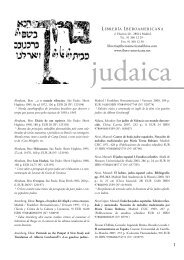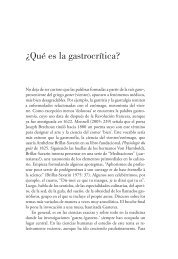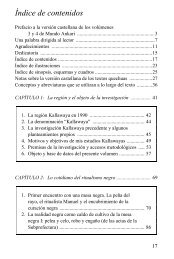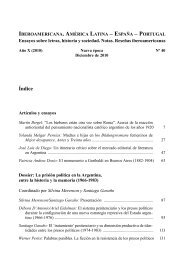Ana Vian Herrero. El indio dividido: Fracturas de conciencia en el ...
Ana Vian Herrero. El indio dividido: Fracturas de conciencia en el ...
Ana Vian Herrero. El indio dividido: Fracturas de conciencia en el ...
Create successful ePaper yourself
Turn your PDF publications into a flip-book with our unique Google optimized e-Paper software.
1306<br />
RENAISSANCE QUARTERLY<br />
<strong>Ana</strong> <strong>Vian</strong> <strong>Herrero</strong>. <strong>El</strong> <strong>indio</strong> <strong>dividido</strong>: <strong>Fracturas</strong> <strong>de</strong> <strong>conci<strong>en</strong>cia</strong> <strong>en</strong> <strong>el</strong> Perú<br />
colonial; Edicion critica y estudio <strong>de</strong> los Coloquios <strong>de</strong> la verdad <strong>de</strong> Pedro <strong>de</strong><br />
Quiroga.<br />
Madrid: Iberoamericana Vervuert, 2009. 572 pp. in<strong>de</strong>x. bibl. $69.57. ISBN: 978–84–8489–<br />
393–6.<br />
<strong>Vian</strong> <strong>Herrero</strong> pres<strong>en</strong>ts the latest, compreh<strong>en</strong>sive study and edition of Los<br />
Coloquios <strong>de</strong> la verdad, one of the earliest primary sources on the spiritual conquest<br />
of the An<strong>de</strong>s. The text was writt<strong>en</strong> around 1560 by Spanish clergyman Pedro <strong>de</strong><br />
Quiroga, possibly a Franciscan friar with ext<strong>en</strong>sive experi<strong>en</strong>ce in the conversion of<br />
An<strong>de</strong>an peoples to Catholicism. Quiroga organized his text as a dialogue betwe<strong>en</strong><br />
Barquilón, a former Spanish conqueror turned hermit; Justino, a Spanish soldier<br />
rec<strong>en</strong>tly arrived in Peru; and Tito, an Indian of Incan <strong>de</strong>sc<strong>en</strong>t. Specialists have long<br />
viewed Quiroga’s prose as <strong>el</strong>egant and comp<strong>el</strong>ling and praised the text as one of the<br />
first literary accomplishm<strong>en</strong>ts in the New World.<br />
<strong>Vian</strong> <strong>Herrero</strong> builds on previous studies of the source, in particular Daisy<br />
Ripodas Ardananaz’s Coloquios <strong>de</strong> la verdad (1999). As a result, the author provi<strong>de</strong>s<br />
a knowledgeable, <strong>en</strong>gaging contextualization of Quiroga’s biography, the political<br />
mom<strong>en</strong>tum in the Peruvian Viceroyalty, and the conundrums of the evang<strong>el</strong>ical<br />
<strong>en</strong>terprise in the An<strong>de</strong>s by mid-sixte<strong>en</strong>th c<strong>en</strong>tury. <strong>Vian</strong> <strong>Herrero</strong> emphasizes the
REVIEWS<br />
1307<br />
importance of dating the text by 1560, shortly prior to the eruption of the nativist<br />
movem<strong>en</strong>t known as Taqui Onqoy. Viewed by scholars as the Indian r<strong>el</strong>igious<br />
response to the first impact of the Spanish conquest, this movem<strong>en</strong>t ma<strong>de</strong> appar<strong>en</strong>t<br />
the instability of the colony’s political and r<strong>el</strong>igious organization. In response, the<br />
Spanish crown implem<strong>en</strong>ted the 1570 Toledan reforms, a compreh<strong>en</strong>sive plan to<br />
secure a more forceful approach to Indian conversion and a complete reform of the<br />
natives’ daily life. Quiroga’s text, <strong>Vian</strong> <strong>Herrero</strong> observes, is th<strong>en</strong> crucial to<br />
un<strong>de</strong>rstanding not only the early years of European influ<strong>en</strong>ce in the An<strong>de</strong>s but<br />
also the actual nature of Spanish colonization.<br />
<strong>Vian</strong> <strong>Herrero</strong> pays <strong>de</strong>tailed att<strong>en</strong>tion to the text. First, she explores the importance<br />
of dialogue as a narrative technique in early mo<strong>de</strong>rn European literature, both in Spain<br />
and the New World. Clergym<strong>en</strong> in the colonies greatly favored the use of fictional<br />
dialogues as narrative settings, the author observes, because the resulting texts could be<br />
used as theater plays, that is, as catechism tools in Indian conversion. Quiroga’s<br />
s<strong>el</strong>ection of this narrative protocol is therefore hardly surprising. The nov<strong>el</strong>ty of the<br />
text, <strong>Vian</strong> <strong>Herrero</strong> remarks, lies in Quiroga’s unapologetic embrace of the Lascasian<br />
paradigm, the sixte<strong>en</strong>th-c<strong>en</strong>tury philosophical <strong>de</strong>f<strong>en</strong>se of Indian rights and culture.<br />
The missionary based his narrative upon the natives’ viewpoint to <strong>de</strong>scribe and<br />
un<strong>de</strong>rstand past and pres<strong>en</strong>t ev<strong>en</strong>ts. In so doing, <strong>Vian</strong> <strong>Herrero</strong> points out, Los<br />
Coloquios <strong>de</strong> la verdad provi<strong>de</strong>s specialists with an invaluable tool for un<strong>de</strong>rstanding the<br />
conquest and colonization of the New World from the natives’ perspective.<br />
<strong>Vian</strong> <strong>Herrero</strong> meticulously analyzes linguistic compon<strong>en</strong>ts of the text. For<br />
instance, she connects the narrative plots used in the speech of two main characters,<br />
Barquilón and Tito, to contemporary and classical literary influ<strong>en</strong>ces in vogue in<br />
Spain. Additionally, the author provi<strong>de</strong>s an <strong>en</strong>gaging analysis of the rhetorical<br />
schemes that Quiroga used throughout his text and connects them to the influ<strong>en</strong>ce<br />
of Erasmus in Spanish literature. Finally, <strong>Vian</strong> <strong>Herrero</strong> examines the speech of Tito,<br />
the rec<strong>en</strong>tly Hispanicized Indian in the story. According to her, the character’s<br />
trilingualism (Spanish, Quechua, and Latin) is indicative of the far-reaching<br />
implications of Quiroga’s standpoint on Indian conversion. For the clergyman,<br />
Indians who had be<strong>en</strong> rec<strong>en</strong>tly exposed to European languages had the pot<strong>en</strong>tial to<br />
become flu<strong>en</strong>t only after a few years. According to <strong>Vian</strong> <strong>Herrero</strong>, this <strong>de</strong>monstrates<br />
Quiroga’s confi<strong>de</strong>nce in the natural aptitu<strong>de</strong> of An<strong>de</strong>ans to become both good<br />
Christians and full subjects of the Spanish empire (273).<br />
The original text is th<strong>en</strong> pres<strong>en</strong>ted with meticulous, easy-to-read annotations<br />
that provi<strong>de</strong> rea<strong>de</strong>rs with <strong>de</strong>tailed information about the manuscript, r<strong>el</strong>evant<br />
contemporary and mo<strong>de</strong>rn bibliography, and linguistic analysis. Transcription<br />
from the original is carefully pres<strong>en</strong>ted and easy to grasp, ev<strong>en</strong> for nonspecialists. In<br />
sum, this is a valuable primary source for the study of early colonial Peru and an<br />
ess<strong>en</strong>tial text for un<strong>de</strong>rstanding the early evang<strong>el</strong>ical <strong>en</strong>terprise in the Americas.<br />
MARÍA N. MARSILLI<br />
John Carroll University


